When I reviewed your initial drawing I was thinking this but your drawing does not show it. In my pool, when in Pool Mode, there are returns to the pool (as normal) and 1 return to the spa. Therefore, water is always circulating in the spa so my chlorinator is only on the pool return but in reality it circulates to both spa and pool. My spa has a spillover so that flows into the pool during Pool Mode. I cannot turn off my single spa return when in Pool Mode - that was how it was set up. This may explain the comment given to you but I have not heard it call a aquator valve.The salt cell and Chlorinators I have always plumbed them on the pool return side since the aquator valve gets calibrated so water always circulate to the pool and spa.”
Austin BYOP Build In Progress - 9/23 Construction Start
- Thread starter UtexasChris
- Start date
You are using an out of date browser. It may not display this or other websites correctly.
You should upgrade or use an alternative browser.
You should upgrade or use an alternative browser.
I will also have a spillover if that matters that is always running when the pump runs. Part of my concern is will Pentair deny any future warranty claims if equipment is not installed based on the recommended specification. After reading this, I’m thinking he meant type to type “actuator valve” instead of “aquator”.
So I think what he’s saying that the spa/pool valve will be calibrated with an automation actuator to ensure it never fully closes.
Does this make sense and is it a best practice?
So I think what he’s saying that the spa/pool valve will be calibrated with an automation actuator to ensure it never fully closes.
Does this make sense and is it a best practice?
I only have 2 automated valves (one on suction and one on return) and they simply turn 180degrees to go from Pool Mode to Spa Mode and back again. Truthfully, I have never disassembled it on the return side so it may have been set to calibrate some flow to the spa side when in Pool Mode. Although my spa spillover is powered by a separate jet (in the spa) that only flows in Pool Mode. In Spa Mode, that specific jet is dormant and the power jets are the flow. Many people have spill over spas and it does help circulate water through the spa and into the pool. It appears your plumber has it set up so that he will calibrate that valve which is shown but there is still is the question as to how it is chlorinated.
I cannot speak to the warranty issues. I do know that it is important that you have an authorized installer because on the Pentair website when you register the equipment they want the name and a PDF of the bill showing the installation.
I cannot speak to the warranty issues. I do know that it is important that you have an authorized installer because on the Pentair website when you register the equipment they want the name and a PDF of the bill showing the installation.
Last edited:
- Jul 21, 2013
- 65,599
- Pool Size
- 35000
- Surface
- Plaster
- Chlorine
- Salt Water Generator
- SWG Type
- Pentair Intellichlor IC-60
So after further conversation it does look like Heater bypasses were installed. @ajw22 Does this look accurate that it would be the 2 valves circled in this screenshot?
Here was the response:
“I have always plumbed heaters and heat pumps with bypass because it’s also recommended by manufacture specially to a heat pump. The by pass it will allowed to control the flow going to a heat pump or to be able to turn one or the other. With the long of a run for your spa you will probably need to run your pump at the higher RPM which I think you can pull up to 120 GPM the capacity for the heater I think is 90 GPM and the heat pump is lower capacity. The whole logic of having a by pass it’s to help the water flow specially for your jets by cracking up the valves so not 100% of flow goes trough your units ,If we plumb everything in series it’s possible to blow out the internals on your heat pump. It happened before and it was blamed on no bypass installed.
I see now the intent of your plumber. What is missing are check valves on the heater output lines to prevent backflow if the heater is leaking or removed for service.
Properly set the valves will allow the heater to run in series.
Have your plumber install the CV's in the heater out lines.
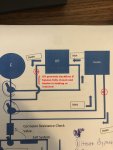
The salt cell and Chlorinators I have always plumbed them on the pool return side since the aquator valve gets calibrated so water always circulate to the pool and spa.”
This gets into the discussion about the negatives of always running your spa spillover. Running the spa spillover creates aeration which causes your pH to rise. It will require more frequent acid additions to keep lowering the pH and countering the spillover pH rise.
Many of us eventually close the actuator valve to the spa when in POOL mode and use the SPILLOVER mode in our automation to run the spillover once or twice a day for 15 to 30 minutes to refresh the spa water with fresh chlorinated water.
The problem remains that as setup now the spa does not get the same level of chlorinated water that the pool is getting.
In my prior post I was pointing out that when in SPA mode and you are using the SPA all the water is flowing though the non-SWG spa side return and you get no chlorination of that water. Your spa will start with some chlorine level but that can rapidly be consumed by the bather load in the spa and the spa water temperature. You don't have the SWG cell replacing the consumed chlorine while using the spa.
In fact with the current setup when in SPA mode the SWG cell will be sitting there in a no-flow condition and off. Unless the cell flow switch fails in which case it can be powered and generating with no flow. That failure state can lead to hydrogen gas buildup in the cell which can explode.
That is why page iii in https://www.pentair.com/content/dam...al_Version_3_units_after_Nov_2011_English.pdf says:
WARNING:CHLORINE GAS BUILDUP CAN OCCUR WITH IMPROPER WIRING: To reduce the risk ofpersonal injury the IntelliChlor® Salt Chlorine Generator (SCG) Power Center must be installed on and wirded to the load side of the time clock, electronically controlled switch, or relay load side, so that it will receive power only when the pool pump is on. Otherwise, dangerous chlorine gas buildup can occur. The IECG should never be energized when the pool pump is OFF and water is not flowing through the unit.
So for those reasons the cell should be moved to before the pool/spa valve so both get chlorine from the SWG at all times the pump is running in either POOL mode or SPA mode or SPILLOVER mode.
- Jul 21, 2013
- 65,599
- Pool Size
- 35000
- Surface
- Plaster
- Chlorine
- Salt Water Generator
- SWG Type
- Pentair Intellichlor IC-60
I will also have a spillover if that matters that is always running when the pump runs. Part of my concern is will Pentair deny any future warranty claims if equipment is not installed based on the recommended specification. After reading this, I’m thinking he meant type to type “actuator valve” instead of “aquator”.
So I think what he’s saying that the spa/pool valve will be calibrated with an automation actuator to ensure it never fully closes.
Does this make sense and is it a best practice?
This gets into the discussion about the negatives of always running your spa spillover. Running the spa spillover creates aeration which causes your pH to rise. It will require more frequent acid additions to keep lowering the pH and countering the spillover pH rise.
Many of us eventually close the actuator valve to the spa when in POOL mode and use the SPILLOVER mode in our automation to run the spillover once or twice a day for 15 to 30 minutes to refresh the spa water with fresh chlorinated water.
Running the spa spillover all the time by having the POOL/SPA valve 90% flow to the pool and 10% flow to the spa predates automation. This is what used to be done to keep the spa water chlorinated because you could not expect a pool owner to be switching valves a few times a day. Now we have automation that can do it at scheduled times.
I run my spa spillover for 15 minutes at 9:30AM to get fresh chlorinated water in my spa at the start of the day after the sun rises. The sun burns off the chlorine during the day. So I run the spillover at 1PM for 15 minutes to refresh the water and chlorination. The same is done at 6PM. So I do three 15 minute runs of the spillover daily.
Nothing we are discussing here creates equipment warranty issues. But it can affect the sanitation of your spa water.
Running the spa spillover all the time by having the POOL/SPA valve 90% flow to the pool and 10% flow to the spa predates automation. This is what used to be done to keep the spa water chlorinated because you could not expect a pool owner to be switching valves a few times a day. Now we have automation that can do it at scheduled times.
This is probably a dumb question, but I'm going to ask it anyway. Is having the valve set to 90% pool flow and 10% spa flow what actually creates the spillover effect? If so, do I understand correctly that there’s no actual plumbing change required to “modify” the existing plan of having the spillover active at all times vs using the spillway mode automation in Intellicenter when I want it active?
I would in theory have pool mode in the automation with all flow to the pool, spillway with 90 pool /10spa, and spa mode all flow to the spa. All of this would be controlled by the automation. In other words, it seems like I pickup more flexibility with the 3 choices described above vs what seemed to be the current plan of operating at 90 pool/10 spa when in pool mode and 90 spa/10 pool when in spa mode mainly to allow chlorination (albeit likely not enough).
Am I understanding this correctly?
- Jul 21, 2013
- 65,599
- Pool Size
- 35000
- Surface
- Plaster
- Chlorine
- Salt Water Generator
- SWG Type
- Pentair Intellichlor IC-60
The return valve being only 90% open to the pool in POOL mode lets the spillover run in pool mode.
With automation you set the return valve so in:
With your current setup you would run 90/10 in pool mode and 100% return to the spa in SPA mode. Actuator only have two positions. The return actuator is set to not close 100% to the spa when in the pool mode position to have the spillover run.
With automation you set the return valve so in:
- POOL mode suction is from the pool and 100% return to the pool
- SPA mode suction is from the spa and 100% return to the spa
- SPILLOVER mode suction is from the pool and 100% return to the spa
With your current setup you would run 90/10 in pool mode and 100% return to the spa in SPA mode. Actuator only have two positions. The return actuator is set to not close 100% to the spa when in the pool mode position to have the spillover run.
With automation you set the return valve so in:
The IntelliCenter turns the valves for these modes.
- POOL mode suction is from the pool and 100% return to the pool
- SPA mode suction is from the spa and 100% return to the spa
- SPILLOVER mode suction is from the pool and 100% return to the spa
I agree this is a much better setup as it provides more flexibility.
Just to confirm, the setup you described above wouldn’t require any changes to the plumbing design (other than placing the salt cell before the pool/spa return valve) given that the intellivalves would be placed on the 3” spa suction valve and the pool/spa return valves and just need to be configured properly in automation? Is this right?
I feel like I just received a masterclass in pool plumbing
TampaKathy
Gold Supporter
Me too, I've been following along for when I get to this step, lol.I feel like I just received a masterclass in pool plumbing
- Jul 21, 2013
- 65,599
- Pool Size
- 35000
- Surface
- Plaster
- Chlorine
- Salt Water Generator
- SWG Type
- Pentair Intellichlor IC-60
I agree this is a much better setup as it provides more flexibility.
Just to confirm, the setup you described above wouldn’t require any changes to the plumbing design (other than placing the salt cell before the pool/spa return valve) given that the intellivalves would be placed on the 3” spa suction valve and the pool/spa return valves and just need to be configured properly in automation? Is this right?
I feel like I just received a masterclass in pool plumbing
No plumbing changes. This is all accomplished by cam settings in the actuator and how you use the automation features.
Understand that Intellivalves are not “Intelli”, yet, if ever. Pentair has not implemented the Intelli features. So the Intellivalve actuators work exactly the same as the dumb actuators.
Thank you, @ajw22 !
Could the corrosion resistant check valve currently before the pool/spa return valve serve the same purpose as the 2 check valves you recommended on the outlet of the heat pump and heater?
Could the corrosion resistant check valve currently before the pool/spa return valve serve the same purpose as the 2 check valves you recommended on the outlet of the heat pump and heater?
- Jul 21, 2013
- 65,599
- Pool Size
- 35000
- Surface
- Plaster
- Chlorine
- Salt Water Generator
- SWG Type
- Pentair Intellichlor IC-60
Thank you, @ajw22 !
Could the corrosion resistant check valve currently before the pool/spa return valve serve the same purpose as the 2 check valves you recommended on the outlet of the heat pump and heater?
No. Asking that says you don't understand what will happen if you don't have the CV in the heater outlets and you have a leak in the heater or the heater is removed and you have two open pipes. See notes in teh pic...
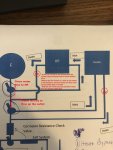
No. Asking that says you don't understand what will happen if you don't have the CV in the heater outlets and you have a leak in the heater or the heater is removed and you have two open pipes. See notes in teh pic...
There goes my passing grade on pool plumbing master class! In all seriousness, this makes complete sense. Thanks for your patience and expertise explaining it to me.
On another note, there’s another valve here that I don’t see in the schematic. As you can see, it’s on the pool return side after the salt cell on the bottom right corner of this pic.
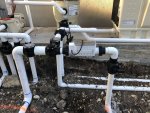
- Jul 21, 2013
- 65,599
- Pool Size
- 35000
- Surface
- Plaster
- Chlorine
- Salt Water Generator
- SWG Type
- Pentair Intellichlor IC-60
When the SWG is unscrewed for service that valve will keep water from the pool flowing out the open pipe.
When the cell is moved before the pool/spa return valve the diverter you are asking about is not needed and should be removed. The pool/spa return valve can be moved to block the intake port to stop any back flow of pool water.
When the cell is moved before the pool/spa return valve the diverter you are asking about is not needed and should be removed. The pool/spa return valve can be moved to block the intake port to stop any back flow of pool water.
Robtown
Bronze Supporter
- Jul 16, 2020
- 135
- Pool Size
- 18500
- Surface
- Plaster
- Chlorine
- Salt Water Generator
- SWG Type
- Pentair Intellichlor IC-60
I agree this is a much better setup as it provides more flexibility.
Just to confirm, the setup you described above wouldn’t require any changes to the plumbing design (other than placing the salt cell before the pool/spa return valve) given that the intellivalves would be placed on the 3” spa suction valve and the pool/spa return valves and just need to be configured properly in automation? Is this right?
I feel like I just received a masterclass in pool plumbing
Hello Fellow Longhorn,
@ajw22 has been giving you great advice and I’m a novice, but you may want to confirm with the plumber if he put a single spa return in line with you pool returns, similar to @HermanTX. If so, then you will always have water going to your spa in pool mode regardless of the 3-way valve set at 100 % pool (instead of 90/10). It doesn’t look like you have independent returns on the pool side, but hopefully they installed a valve on that spa return at some point so you can turn it off completely.
I’m having a spa bypass loop added to my plumbing so I can control how much flow I want to the spa if any at all during normal pool operation. I didn’t think about setting the Pool Mode at 90/10 and using that Intellivalve to dial in that flow instead. I might have to consider that option instead. Although the cost of the diverter and check value plus the little extra plumbing isn’t too much to have that ability so I’ll probably keep it and then never use it.
DB-Cooper
Well-known member
- Jun 18, 2019
- 594
- Pool Size
- 30000
- Surface
- Plaster
- Chlorine
- Salt Water Generator
- SWG Type
- Pentair Intellichlor IC-60
For what it's worth, my pool builder also installed my IC60 on the wrong side of the Pool/Spa actuator and didn't give me a full 18". I argued for him to do it right and I got all this, "We never do that, you don't want to chlorinate your spa, just use the spa return in pool mode, don't overchlorinate." I showed him the instructions and he was dismissive, I also showed him how Pentair automation does NOT allow more than 20% IC setting in Spa mode for the exact reason/concern he had. He sort of ignored my request for a couple weeks, but when he asked for "Pool Startup" check, I said, "I'm still waiting for my IC60 to be installed per Pentair's instructions, once done I'll consider start up complete". His plumber was there in 30 minutes, it took him maybe 20 minutes to re-run.
Gotta hold your ground, now that it's spa season, I'm really glad mine is installed right!
Gotta hold your ground, now that it's spa season, I'm really glad mine is installed right!
Hook em @Robtown and thanks for the callout. I would think that it would be in the schematic but definitely better to verify. thanks @DB-Cooper . Makes me wonder if I have the same plumber who your builder used. The plumber has been great up to this point so I’m confident we’ll get it fixed. I also have a pentair warranty repair appointment this morning as the salt cell had a leak and they’re coming to install a new one. It will be interesting to see if the tech also calls this out. I’ll keep everyone posted.
Thanks everyone again for all of your help. The plumber is coming later this week to add the check valves, move the salt cell, ensure at least 12” of straight pipe, and remove the valve currently after the salt cell on the pool side.
I have some updates...
1. The IC60 has been moved the before the pool/spa valve.
2. Check valves have been added as advised to heat pump and heater/cooler.
3. I now have the recommended 12-18” before the cell.
4. Gunite was completed on Friday! They started at 7am and finished at 6pm. What a cool process to watch!
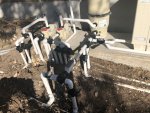
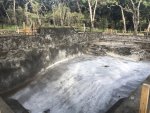
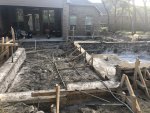
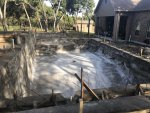
1. The IC60 has been moved the before the pool/spa valve.
2. Check valves have been added as advised to heat pump and heater/cooler.
3. I now have the recommended 12-18” before the cell.
4. Gunite was completed on Friday! They started at 7am and finished at 6pm. What a cool process to watch!




Thread Status
Hello , This thread has been inactive for over 60 days. New postings here are unlikely to be seen or responded to by other members. For better visibility, consider Starting A New Thread.

